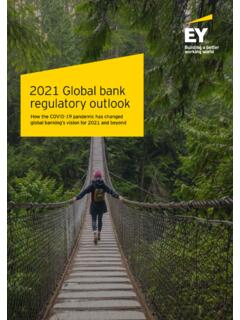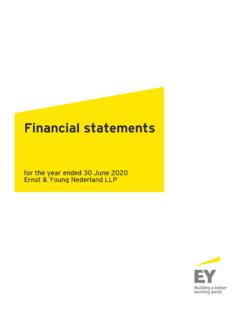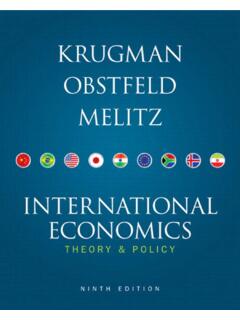Transcription of Impacts of IFRS 17 insurance contracts accounting standard
1 Impacts of ifrs 17. insurance contracts accounting standard Considerations for data, systems and processes Across the globe, an unprecedented wave of new reporting and regulatory requirements are driving changes that are significantly impacting the way insurers manage their business. The new financial reporting standard ifrs 17 will undoubtedly represent the most significant change to insurance accounting requirements in over 20 years. ifrs 17 is scheduled to be applied for reporting periods starting on or after 1 January 2021. Its dynamics will not only have implications on the financial disclosures of insurers it will also have profound operational Impacts on all aspects of the organization. EY is already supporting many insurers across the globe in implementing ifrs 17 and we can see that the industry faces tough challenges in understanding the operational Impacts on data, systems and processes. ifrs 17 requirements trigger questions around: the fundamental data management strategy, including data quality, storage and archiving the end-to-end systems architecture design and the different actuarial, risk and accounting processes that will support the future reporting process and how they will interact In the next years insurers will need to implement significant technical and practical changes in order to appropriately respond to these questions.
2 We believe the most efficient way to approach this will be through an integrated operating model and technology platform for Finance and Actuarial, enabling them to work as one unified team with one seamless calculation and reporting system. We see generally three solution approaches to meet the new data, system and process challenges: 1. Actuarial driven solution - Leverage existing data, system and processes for ifrs 17 and build on MCEV/Solvency II tools and models wherever sensible 2. Integrated ifrs 17 solution - Build ifrs 17 capabilities through the introduction of an integrated solution that connects the finance and actuarial systems 3. GL embedded solution - Provide an ifrs 17 platform through a central finance system There are significant opportunities to use ifrs 17 as a catalyst for further changes needed in supporting functions such as Finance and Actuarial. It is clear that no single approach works for the entire industry.
3 Whatever the approach, we believe that only with a truly integrated solution that closely connects the data, systems and process environment between Finance and Actuarial will insurers be able to meet the challenges of the future. This paper makes the case for why insurers need to understand the new data, systems and process challenges before they start committing to a demanding implementation journey that is likely to be transformational. It also looks at the considerations and options for an ifrs 17 solution that will ultimately need to combine what is needed to comply with the ifrs 17 requirements and at the same time have to meet the insurers' finance strategy and business objectives. Lastly we provide practical actions to guide an implementation that's focused, sustainable, and able to deliver the expected results. Impacts of ifrs 17 | 2. Contents 1. The reporting challenge 2. Operational implications 3.
4 Solution options 4. Next steps 5. Tools and accelerators 6. Case studies Impacts of ifrs 17 | 3. The reporting challenge 1. The most significant change to insurance accounting requirements in 20 years On 18 May 2017 the International accounting Standards Board (IASB or Board) issued ifrs 17 insurance contracts (The standard ). The standard will be first applied for reporting periods starting on or after 1 January 2021. ifrs 17 represents the most significant change to insurance accounting requirements in over 20 years it demands a complete overhaul of insurers' financial statements. This major change program to implement ifrs 17 will extend beyond the finance and actuarial functions of insurers with a large impact across Data, Systems and Processes (DSP). Its business Impacts need to be understood and communicated to a wide range of internal and external stakeholders. Given the scale of this change, investors and other stakeholders will want to understand the likely impact as early as possible.
5 The standard uses three measurement approaches: The General Model Premium Allocation Variable Fee Approach (GM) Approach (PAA) (VFA). Default valuation approach Optional simplified Applies to contracts for non-participating approach for contracts with direct participation contracts with a duration of one year features, as defined by or less, or where it is a three criteria, based on insurance contract valued reasonable approximation policyholders sharing using fulfilment cash of the General Model in the profit from a flows the present value clearly identified pool of of probability weighted insurance contract valued underlying items expected future cash flows as a liability for remaining plus a risk adjustment coverage and an incurred insurance contract claims liability liability based on the Plus a contractual service obligation for the entity margin (CSM), which Similar approach to to pay the policyholder represents the profit the existing non-life insurance an amount equal insurer recognizes based contract measurement to the value of the on the transfer of services for liability for remaining underlying items, net of to policyholders over time.
6 Coverage a consideration charged Incurred claims liability for the contract a discounted plus a risk variable fee . adjustment The principles underlying these measurement approaches result in a fundamental change to current practices. The detailed requirements are markedly different from existing models in a number of critical aspects that will: Change profit emergence patterns Speed up the recognition of losses on contracts that are expected to be onerous Add complexity to valuation processes, data requirements, assumption setting and analysing and communicating results Greater granularity in contract groupings for valuation purposes will create additional complexity in the valuation models, data, system and process requirements. Impacts of ifrs 17 | 4. The reporting challenge 1. Countdown to 2021 has started How do you prepare for the Impacts of ifrs 17? In the coming years, insurers will need to interpret, understand and apply the new standard to their insurance contracts and reporting a process involving significant time and effort.
7 The major change program required will extend beyond finance and actuarial teams and its Impacts will need to be communicated to a broad range of internal and external stakeholders. The timeline below shows the countdown to ifrs 17. Given the scale of change required and the complexity of the implementation task, especially around DSP, insurers should start formally assessing Impacts and mobilize their organizations now. Exhibit 1: Countdown to ifrs 17 (for December year-end). Disclosure of expected Potential implementation First ifrs 17-compliant Impacts of the standards of ifrs 9 or re- nancial statements to be issued, but not yet effective1 classi cation on ifrs 17 published transition 2017 2018 2019 2020 2021 2022. ifrs 17 ifrs 9 ifrs 17 start of ifrs 17. issued on 18 May effective date comparative period Effective date 1 Jan 2021. ifrs 4 ifrs 4 and ifrs 17 ifrs 17. (parallel run). Note: 1. The early adoption of ifrs 17 is permitted provided insurers have also adopted ifrs 9 and ifrs 15.
8 Qualifying insurers can delay the implementation of ifrs 9 until the date of adoption of ifrs 17. Impacts of ifrs 17 | 5. Operational implications 2. Why data, systems and processes are important to ifrs 17. We recommend a holistic approach to the implementation, covering the different dimensions of the Finance Target Operating Model (TOM). In discussions with insurers around the world, we found that most expect to face challenges understanding the operational Impacts on DSP and it is therefore important to begin considering the changes now. The diagram below shows some of the Impacts of ifrs 17 on the The implementation of ifrs 17 Finance TOM. will have profound Impacts on all aspects of your organization, Processes from front- to-back office. Setting materiality concepts/guidelines Updating closing and reporting processes, actuarial processes, planning procedures, risk management Changes to internal and external reporting templates including group reporting packages Internal controls and audit trail Planning, budgeting and forecasting processes Policy Performance Management New accounting policies/ Changes in Management Information guidelines and control reports and Key Performance Indicators procedures Policy Processes Performance Value-based management, scorecards ifrs 17 calculation Management and incentive scheme adjustments methodology guidance and reporting instructions Organization Actuarial models and Roles and responsibility changes assumptions setting and (especially between Actuarial and Organization inputs Finance).
9 General Ledger (GL) Chart Technical provisions assumptions /expert of Accounts changes and judgment committee local account mappings Impacts on outsourcing contracts Data People Systems Investment policy changes Consolidated group vs entity level ( ifrs 9) reporting Data People Systems New financial reporting data Technical and functional Impacts on core insurance systems, requirements (input/output) at more training investment systems, actuarial systems, detailed granularity reporting systems Cross-functional collaboration Data reconciliations at different levels (Business, Technology, Finance New posting logic/engines for ifrs 17. Data quality, storage and archiving and Risk). GL, consolidation tool and reporting Data security and controls Project resourcing and budget system changes Data governance and master data managing change fatigue Changes to system interfaces Demand for a single-source of truth for Demand for of flexibility in the actual finance and risk data system landscape New system functionalities/features Impacts of ifrs 17 | 6.
10 Operational implications 2. Work back from the future state to identify data requirements ifrs 17 will require organizations to ensure data governance, lineage and transparency across the entire reporting chain. This includes a wide spectrum of data that will be used, from historic or current data ( policy and premium data or data to produce the risk adjustment) to forward-looking data ( data used to produce cash flow projections). While there are various solution To start, insurers should work with internal and external stakeholders to options organizations should assess the current data flows and identify potential gaps. In doing so, it is critical to have the future state in mind to identify data requirements take a comprehensive data across the existing data and systems landscape. management approach to In addition to data flow and system analysis, it is important to review your improve data and analytics data management capabilities at the enterprise level.










